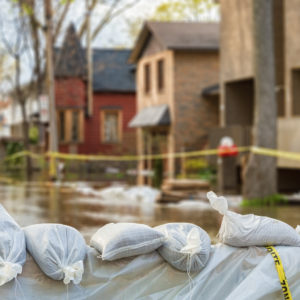With Congress weighing whether to pass legislation that would preserve a federally-backed flood insurance program, a notable alliance of budget hawks, scientists, private insurers, and environmentalists are warning that the lawmakers must rethink broader disaster-preparedness policies to save the program and protect Americans.
The National Flood Insurance Program provides coverage for more than five million homeowners around the country. But it has been on the brink of financial collapse as it operates at a loss at a time when costly natural disasters are seemingly on the rise as a result of dramatic swings in the Earth’s climate.
The situation has prompted experts from the environmental movement, the scientific community, and the insurance industry to gather this week at Columbia University to discuss a range of policy options that could help alleviate the financial burdens confronting the National Flood Insurance Program, as well as protect Americans from floods and other costly and dangerous natural disasters.
Participants at the gathering, entitled “Climate Change: Response and Resilience Leadership Forum,” are expected to take up a number of relevant questions, including: Can policymakers and government agencies better protect communities facing hurricanes, floods and other extreme weather events? What is the appropriate role of government in education and mitigation before a serious weather event? What can coastal communities do to protect against rising sea levels and increased rainfall? Can businesses and homeowners draw from forest-management techniques to cope with growing incidences wildfires?
Congress has until Dec. 8 to decide the fate of the program, leaving millions of Americans who rely on the insurance it provides in a state of limbo. As the deadline for Congress approaches, a number of problems with the program have been identified, both in and outside of Capitol Hill.
The National Flood Insurance Program, designed more than a half-century ago, has been criticized for a number of reasons. The criticisms include that it has been operating in the red for years, has exceeded its legal borrowing authority, and has not paid claims to Americans seeking reimbursement for past natural disasters.
But perhaps one of the biggest criticisms the program has faced is that it has made it possible for homeowners to rebuild in coastal areas susceptible to flooding.
The New York Times, for example, reported that the program has paid billions of dollars to rebuild homes that end up being damaged once again in subsequent floods. The newspaper says that that includes spending nearly $1 million for repairs 19 different times to a house in Spring, Texas that is worth just $42,024.
Currently, the federal government dominates the flood-insurance market, a situation that Congress did not envision or want when it created the National Flood Insurance Program in 1968. As a result, the federal government not only writes the rules and sets the rate for flood insurance, it also shoulders all the risk involved in covering households across the country.
But it has become increasingly difficult for the government to be in the flood-insurance business, as costs rise with the increasing frequency of catastrophic storms and floods that require billions of dollars to recover.
It is against that backdrop – and other climate-driven disasters – that the various experts are gathering Columbia University. To individuals involved, it is just as important to consider broader questions beyond those involving the extension of the flood-insurance program.
For instance, the experts on hand will explore questions of what role climate change has in the incidence of hurricanes and what impact higher temperatures might have on human health and habitability of certain areas. The gathering will open with remarks by Jared Snyder, Deputy Commissioner for Air Resources, Climate Change & Energy at the New York State Department of Environmental Conservation.

